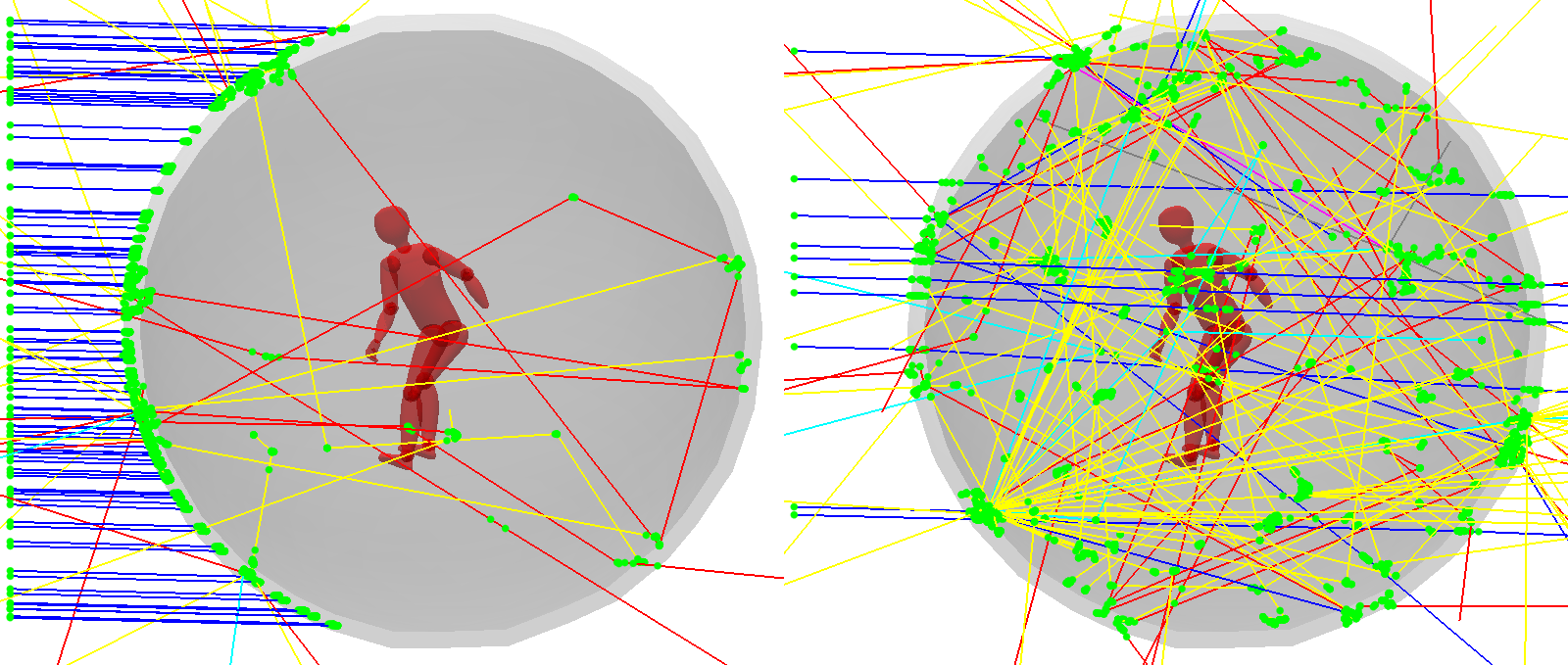Skoltech alumnus Dr. Mikhail Dobynde and his colleagues from the U.S. and Germany have identified a window of opportunity for a manned spaceflight to Mars and back in the mid-2030s. According to simulations run by the team, that period will be favorable in terms of the relative positions of the planets and solar activity, with the radiation emitted by the sun offsetting the more dangerous cosmic rays from the interstellar space. The findings are reported in Space Weather.
 Effect of harmful radiation on an astronaut protected by 10 gram per square centimeter aluminum shielding. The picture on the left illustrates 100 protons hitting the spacecraft with energies of 100 megaelectronvolts. On the right, there are only 10 protons coming in, but with 10 times more energy. The blue lines indicate primary protons, with the resulting secondary particles shown in red (neutrons), yellow (gamma rays), and cyan (electrons). The green dots indicate particle-matter interactions. Image Credit: Dr. Mikhail Dobynde/Skoltech
Effect of harmful radiation on an astronaut protected by 10 gram per square centimeter aluminum shielding. The picture on the left illustrates 100 protons hitting the spacecraft with energies of 100 megaelectronvolts. On the right, there are only 10 protons coming in, but with 10 times more energy. The blue lines indicate primary protons, with the resulting secondary particles shown in red (neutrons), yellow (gamma rays), and cyan (electrons). The green dots indicate particle-matter interactions. Image Credit: Dr. Mikhail Dobynde/Skoltech
With a renewed interest in manned spaceflight, national space agencies and private corporations are eyeing the moon and Mars as the most enticing destinations for the coming decades. But while the news about the space race between Virgin Galactic, Blue Origin, and SpaceX might make it look like earlier launch dates are always better launch dates, space weather actually has a major say in when a certain mission is possible or feasible.
The radiation hazard in space is a major concern in any long-term mission. It is more than unhealthy for the astronauts, and there is a limit to how much shielding a spaceship can be fitted with before it gets too heavy and expensive to launch. This is why Skoltech researcher Dr. Mikhail Dobynde and his co-authors suggest adapting to space weather as opposed to going against it.
A spacecraft on a course from the Earth to Mars and back is exposed to cosmic rays coming from interstellar space and to energetic particles emitted by our own sun, which operates under the so-called 11-year cycle: Every 11 years, the sun exhibits a maximum in its activity, emitting the most radiation.
While this might appear counterintuitive, flying a spacecraft to Mars during the solar maximum is actually not a bad idea at all. The reason is that solar energetic particles are easy enough to shield from, and putting up with their outbursts provides an unexpected benefit: The flux of radiation from the sun actually wards off the more harmful galactic cosmic rays.
The researchers ran a simulation predicting radiation levels inside a spacecraft. The study accounts for 28 kinds of hazardous particles of interstellar origin and 10 emitted by the sun during solar flares. These are all ions — positively charged atomic nuclei with ripped off electrons — with the difference that potentially heavier and more dangerous species can come in from outside the solar system. To give you an idea of how nasty these galactic rays can be, they can actually bump into the atoms making up the spacecraft hard enough to cause a nuclear reaction and make the ship itself radioactive! In that sense, solar radiation is the astronaut’s best friend.
“We have identified the optimal combination of spacecraft shielding and the launch date which enables the longest flight duration. Our calculations show that the best time to start a manned flight to Mars and back is during the decaying phase of solar activity. If the average shielding is 10 cm of aluminum, the mission could last up to four years without exceeding the allowed radiation risk limit. Since the next solar max is coming up fairly soon — somewhere around the year 2025 — Mars might just have to wait until the mid-2030s,” commented the study’s first author, Dr. Mikhail Dobynde of Skoltech. The study also featured researchers from the GFZ German Research Centre for Geosciences, the University of Potsdam, the University of California at Los Angeles, and MIT.
The authors continue their studies on the efficiency of different shielding materials and the radiation environments on the surface of Mars and the moon.